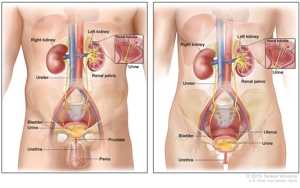Kidney Cancer

Anatomy of the male urinary system (left panel) and female urinary system (right panel); two-panel drawing showing the right and left kidneys, the ureters, the bladder filled with urine, and the urethra. The inside of the left kidney shows the renal pelvis. An inset shows the renal tubules and urine. Also shown are the prostate and penis (left panel) and the uterus (right panel). Click to see a larger diagram.
© 2010 Terese Winslow LLC, U.S. Govt. has certain rights. Used with Permission. Contact artist at www.teresewinslow.com for licensing.
Cancer is a disease in which cells in the body grow out of control. When cancer starts in the kidney, it is called kidney and renal pelvis cancer. It can also be called renal cell cancer as that is the most common type of kidney and renal pelvis cancer. Every year, more than 37,000 men and 21,000 women get kidney and renal pelvis cancers, and more than 9,000 men and 4,000 women die from these diseases.
To lower your risk of kidney and renal pelvis cancers, don’t smoke, or quit if you do. Be very careful if you work with the chemical trichloroethylene.
What Are the Kidneys?
The body has two kidneys, one on each side of the body, located behind the liver and stomach. The kidneys make urine, which is how the body washes liquid waste out of the body. The kidneys also play a role in controlling blood pressure and stimulating the bone marrow to make red blood cells.
What Is the Renal Pelvis?
The renal pelvis is in the center of the kidney and is responsible for collecting the urine and feeding it into the ureters, two tubes that connect the kidneys with the bladder. The bladder holds urine until it is peed out.
What Causes Kidney and Renal Pelvis Cancers?
Smoking is the most important risk factor for kidney and renal pelvis cancers. Other risk factors include—
- Being obese.
- Taking certain pain medicines for a long time.
- Having high blood pressure. It is not known whether the increased risk is due to high blood pressure itself or the medicines used to treat it.
- Having certain genetic conditions.
- Being exposed to a chemical called trichloroethylene, which is used to remove grease from metal.
What Are the Symptoms of Kidney and Renal Pelvis Cancers?
A person with kidney or renal pelvis cancer may or may not have one or more of the symptoms listed here. The same symptoms can also come from other causes. If you have any of these symptoms, talk to your doctor.
- A lump or mass in the kidney area or abdomen.
- Blood in the urine.
- Lower back pain or pain in the side that doesn’t go away.
- Feeling tired often.
- Fever that keeps coming back.
- Not feeling like eating.
- Losing weight for no reason that you know of.
- Something blocking your bowels.
- A general feeling of poor health.
How Can I Reduce My Risk for Kidney and Renal Pelvis Cancers?
To lower your risk of kidney and renal pelvis cancers—
- Don’t smoke, or quit if you do.
- Keep a healthy weight.
- Eat a healthy diet.
- Exercise.
- Be very careful if you use certain kinds of chemicals, especially trichloroethylene. This chemical is used by workers in some jobs, like those that work with metals.
Statistics
In the United States in 2014 (the most recent year for which numbers are available)—
- 59,395 people (37,531 men and 21,864 women) got kidney and renal pelvis cancers.
- 13,917 people (9,203 men and 4,714 women) died from kidney and renal pelvis cancers.
- Among men, black men are the most like to get kidney and renal pelvis cancers (24.7 per 100,000 men), followed by white men (22.0), Hispanic† men (20.6), American Indian/Alaska Native men (19.5), and Asian/Pacific Islander men (10.4).
- Among women, black women are the most like to get kidney and renal pelvis cancers (12.4 per 100,000 women), followed by Hispanic† women (11.9), white women (11.4), American Indian/Alaska Native women (10.8), and Asian/Pacific Islander women (4.9).
†Hispanic origin is not mutually exclusive from race categories (white, black, Asian/Pacific Islander, American Indian/Alaska Native).
Data source: U.S. Cancer Statistics Working Group. United States Cancer Statistics: 1999–2014 Incidence and Mortality Web-based Report. Atlanta (GA): Department of Health and Human Services, Centers for Disease Control and Prevention, and National Cancer Institute; 2017. Available at: http://www.cdc.gov/uscs.
More Information
- Kidney Cancer (National Cancer Institute)
- Kidney Cancer (Adult) – Renal Cell Carcinoma (American Cancer Society)
- Smoking & Tobacco Use: Cancer
- Chemicals, Cancer, and You [PDF-4.7MB]
- Page last reviewed: June 7, 2017
- Page last updated: June 7, 2017
- Content source:


 ShareCompartir
ShareCompartir